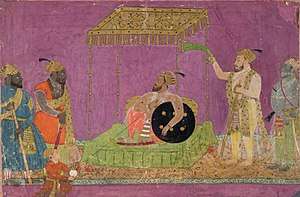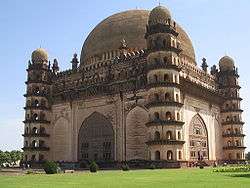Mohammed Adil Shah, Sultan of Bijapur
Mohammed Adil Shah was the seventh ruler of Bijapur, ascending the throne in 1627. He is buried in the Gol Gumbaz.
| Mohammed Adil Shah | |||||
|---|---|---|---|---|---|
| Adil Shahi Emperor | |||||
 Muhammad Adil Shah with courtiers and attendants. | |||||
| Reign | 12 September 1627 – 4 November 1656 | ||||
| Predecessor | Ibrahim Adil Shah II | ||||
| Successor | Ali Adil Shah II | ||||
| Born | Bijapur | ||||
| Died | 4 November 1656 Bijapur | ||||
| Burial | Gol Gumbaz | ||||
| Spouse | Taj Jahan Begum (daughter of Abdur Rahman Quadri) Khadija Sultana (daughter of Sultan Muhammad Qutb Shah) Uroos Begum | ||||
| Issue | Ali Adil Shah II | ||||
| |||||
| Dynasty | Adil Shahi Empire | ||||
| Father | Ibrahim Adil Shah II | ||||
| Mother | Taaj Sultana or Badi Sahiba | ||||
| Religion | Shia Islam | ||||
Rule

Bijapur partnered with the Mughals in the extinction of Ahmednagar. Mohammed maintained friendly relations with Shah Jahan and made a peace treaty of 1636, after the extinction of Ahmednagar. By a farman of Shah Jahan, he got assurances for the end of Mughal aggression against Bijapur and due to his good relations with the Mughals, Shah Jahan formally recognized Muhammad’s sovereignty and bestowed upon him the title of Shah in 1648, the only ruler of Bijapur to receive such recognition from the Mughals.
The Treaty of 1636 with the Mughals sealed the expansion of Bijapur in the north. So, Mohammed Adil Shah extended his dominations westwards into Konkan, Pune, Dhabul (present Mumbai), southwards into Mysore, and eastwards into Karnataka, present south Andhra Pradesh and Tamil Nadu. During his reign, the kingdom attained its greatest extent, power and magnificence, and his dominions stretched from the Arabian Sea to the Bay of Bengal.
Besides territorial expansions, Bijapur also attained peace and prosperity during Mohammed’s reign. His kingdom yielded an annual revenue of seven crore eighty four lakh rupees, besides the five and half crores of tributes that were from vassal rulers and zamindars. Cultural activities like poetry, painting and architecture also received a great impetus. Mohammed Adil Shah did his best to emulate the glorious traditions left to him by his versatile father. Diffusion of general education and religious teachings were one of his chief concerns, and he did his utmost to improve the socio-economic and educational standards of the people.
Mohammed continued his father's patronage of the arts, though on a lesser scale. He introduced fresco paintings and portraits, the examples of which are the walls of Asar Mahal, pavilion at Kumatgi and Sat Manzil.
Rise of Marathas
Mohammad’s reign witnessed revolt of Shahaji and then, the rise of Shivaji to eminence and his founding of an independent Maratha State, which was initially carved out of the Bijapur Kingdom. Mohammed failed to check the rise of Marathas to independence.
Death

After an extended illness, Mohammad died and was succeeded by his son Ali Adil Shah II.[1]
Tomb
He was buried in the Gol Gumbaz, near the tomb of his spiritual teacher Hashimpeer Dastageer. Hashimpeer arrived in Bijapur at the rule of Ibrahim Adil Shah II. Hashimpeer influenced the rulers of Bijapur to give up their un-Islamic and heretic practices. Gol Gumbaz, located near the shrine of Hashimpeer, owes its completion to the 10 years of life that Hashimpeer granted to his disciple Adil Shah.
The dome of the Gol Gumbaz is the second largest in the world, 44 m (124 ft) in diameter.[2] The Gol Gumbaz complex includes a mosque, a Naqqar Khana (a hall for the trumpeters, now it is used as museum) and the ruins of guest houses.
References
- John F. Richards, The Mughal Empire, (Cambridge University Press, 1995), 157.
- Utilizing Ready Mix Concrete and Mortar: Proceedings of the International Conference, ed.Ravindra K. Dhir and Mukesh C. Limbachiya, (Thomas Telford Publishing, 1999), 212.
| Preceded by Ibrahim Adil Shah II |
Adil Shahi Rulers of Bijapur 1627–1656 |
Succeeded by Ali Adil Shah II |